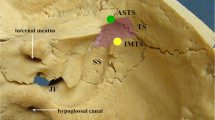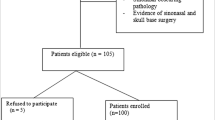Abstract
Background
A coordinate system was previously developed to identify landmarks on the skull surface to help locate the transverse-sigmoid sinus junction in order to reduce surgical morbidity in retrosigmoid craniotomy; however, in practice we found that this system has important flaws.
Objective
To develop and evaluate a novel reference coordinate system to precisely locate the inferomedial point of the transverse-sigmoid sinus junction (IMTS) and evaluate the effect of gender and skull side (left or right).
Methods
Forty-two adult skulls (84 sides) were obtained for analyses. The X-axis was defined by point A (where the upper edge of the zygomatic arch joins with the frontal process of the zygomatic bone) and point B (where the upper edge of the zygomatic arch blends posterosuperiorly into the supramastoid crest). The Y-axis was defined by the line perpendicular to the X-axis and extending across the tip of the mastoid. The x and y coordinates of IMTS (IMTS-x and IMTS-y) were measured in this coordinate system.
Results
There were 20 male skulls and 22 female skulls. The mean IMTS-x measurements were significantly higher on the right side compared with the left side in both males and females. For the left skull side, the mean IMTS-y measurements were significantly lower in females compared with males.
Conclusion
This novel reference coordinate system may be a reliable and practical method for identifying the IMTS during retrosigmoid craniotomy. There are significant differences in location of the axes with regard to gender and skull side.




Similar content being viewed by others
References
Rhoton AL Jr (2000) The cerebellopontine angle and posterior fossa cranial nerves by the retrosigmoid approach. Neurosurgery 47:S93–S129
Day JD, Tschabitscher M (1998) Anatomic position of the asterion. Neurosurgery 42:198–199
Pait TG, Harris FS, Paullus WS, Rhoton AL Jr (1977) Microsurgical anatomy and dissection of the temporal bone. Surg Neurol 8:363–391
Vrionis FD, Robertson JH, Heilman CB, Rustamzedah E (1998) Asterion meningiomas. Skull Base Surg 8:153–161
Martinez F, Laxague A, Vida L, Prinzo H, Sgarbi N, Soria VR, Bianchi C (2005) Topographic anatomy of the asterion. Neurocirugia (Astur) 16:441–446 (in Spanish)
Mwachaka PM, Hassanali J, Odula PO (2010) Anatomic position of the asterion in Kenyans for posterolateral surgical approaches to cranial cavity. Clin Anat 23:30–33
Ribas GC, Rhoton AL Jr, Cruz OR, Peace D (2005) Suboccipital burr holes and craniectomies. Neurosurg Focus 19:E1
Ucerler H, Govsa F (2006) Asterion as a surgical landmark for lateral cranial base approaches. J Craniomaxillofac Surg 34:415–420
Avci E, Kocaogullar Y, Fossett D, Caputy A (2003) Lateral posterior fossa venous sinus relationships to surface landmarks. Surg Neurol 59:392–397, discussion 397
Lang J Jr, Samii A (1991) Retrosigmoidal approach to the posterior cranial fossa. An anat study Acta Neurochir (Wien) 111:147–153
Bozbuga M, Boran BO, Sahinoglu K (2006) Surface anatomy of the posterolateral cranium regarding the localization of the initial burr-hole for a retrosigmoid approach. Neurosurg Rev 29:61–63
Tubbs RS, Loukas M, Shoja MM, Bellew MP, Cohen-Gadol AA (2009) Surface landmarks for the junction between the transverse and sigmoid sinuses: application of the “strategic burr hole for suboccipital craniotomy. Neurosurgery 65:37–41, discussion 41
da Silva EB Jr, Leal AG, Milano JB, da Silva LF Jr, Clemente RS, Ramina R (2010) Image-guided surgical planning using anatomical landmarks in the retrosigmoid approach. Acta Neurochir (Wien) 152:905–910
Gharabaghi A, Rosahl SK, Feigl GC, Liebig T, Mirzayan JM, Heckl S, Shahidi R, Tatagiba M, Samii M (2008) Image-guided lateral suboccipital approach: part 1-individualized landmarks for surgical planning. Neurosurgery 62:18–22, discussion 22–13
Gharabaghi A, Rosahl SK, Feigl GC, Safavi-Abbasi S, Mirzayan JM, Heckl S, Shahidi R, Tatagiba M, Samii M (2008) Image-guided lateral suboccipital approach: part 2—impact on complication rates and operation times. Neurosurgery 62:24–29, discussion 29
Xia L, Zhang M, Qu Y, Ren M, Wang H, Zhang H, Yu C, Zhu M, Li J (2012) Localization of transverse-sigmoid sinus junction using preoperative 3D computed tomography: application in retrosigmoid craniotomy. Neurosurg Rev 35:593–598, discussion 598–599
Financial Support
Clinical specific projects from Ministry of Public Health of China (106) and National Natural Science Foundation of China (81371349).
Conflicts of Interest
None.
Author information
Authors and Affiliations
Corresponding author
Rights and permissions
About this article
Cite this article
Li, Rc., Li, K., Qi, L. et al. A novel reference coordinate system to locate the inferomedial point of the transverse-sigmoid sinus junction. Acta Neurochir 156, 2209–2213 (2014). https://doi.org/10.1007/s00701-014-2204-8
Received:
Accepted:
Published:
Issue Date:
DOI: https://doi.org/10.1007/s00701-014-2204-8




